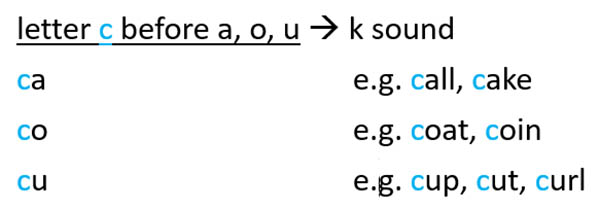It would be so much simpler if the English alphabet had one sound for every letter and only one letter for each sound. It does not. Sometimes a sound has two letters or a letter makes no sound at all. The letter K has a few issues to be aware of. Sometimes the K-sound is spelt with a letter K, letter C or even a CK or CH or others. Today I will look at K sound pronunciation patterns and the reasons behind them.
The letter K was rare in Old English, instead the letter C was used for the K-sound. Even Latin used C or Q for the K-sound. However in English the letter C before E, I or Y became a problem, after the Norman invasion of England in 1066. In Norman French that spelling would be a soft C, with an S sound. So in Middle English, the letter C was switched to K before E, I or Y. For example the Old English cyning became king and cene became keen.
The above K-sound spelling pattern suggests another. If C was switched to K before E, I or Y, what happened to the letter C before A, O and U? When the letter C is before A, O or U it still makes a K sound as in call, cake, coat, coin, cup, cut and curl. The result of this spelling pattern is that Modern English words from Old English are usually spelt with a C for the K-sound before A, O and U.
There are words in Modern English with a K before these vowels, but these exceptions were borrowed later from other languages. These exceptions include: KA Examples: kangaroo (native Australian), kamikaze (Japanese) and kaolin (from Gaoling, the name of a mountain in Jiangxi province). KU examples include the nerve disease kuru (Fore, language of eastern highland Papua New Guinea), kumquat (Cantonese) and kung fu (Mandarin). KO examples include the Koran (Arabic), kosher (Hebrew) and kowtow (Mandarin).
There are some miscellaneous patterns to note. The KH combination only appears in foreign words that are aspirated (stretched out pronunciation) in their original language (lakh, khaki and khan) and in the middle of compound words (bulkhead, sinkhole and backhand). A doubled consonant KK is generally only found in foreign words (pukka, Hakka and Hanukkah) and in the middle of compound words (bookkeeping, jackknife and steakknife). These are not found in enough words to be a regular spelling pattern.
In the next two articles I will cover other K-sound spelling patterns. This simple letter sound is not simple at all. Be sympathetic with children trying to learn this stuff.
Related Articles:
‧AW
‧B
‧CK
‧CC
‧SC
‧Silent D Is Not Always Silent
‧D
‧Hard And Soft G Spelling Patterns
‧No English words end with the letter i?
‧NG
‧When is Initial U Short and when is it Long?
‧X
‧Pronouncing The Letter Y At The Front Of A Word
‧Pronouncing The Letter Y In The Middle Of A Word
‧Pronouncing The letter Y At The End Of A Word
‧The letter Y & The Double Vowel Rule
‧The Last Letter is a Foreigner
‧Silent letters and why English spelling is such a mess (1): Old English
‧Silent letters and why English spelling is such a mess (2): Fake Latin
‧I Both Love and Hate Spell-Checkers
‧The Rule: I before E, except after C
by John Larrysson [email protected]
A native English speaker who has been teaching practical English in Hong Kong for over two decades.
**********************************************************
NOTE: Starting in 2016, this column has been published once every two weeks, on every other Tuesday.
General Enquiry: We welcome enquiries and feedback. Please contact us through [email protected]




